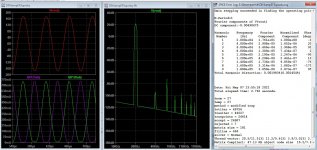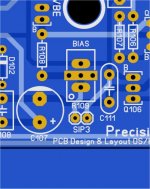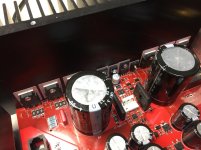I've always said any rail fuses belong at the supply. If they are going to be there they should be before the wire connecting the amp to protect from it shorting. Also nobody seems to be aware of what happens when one rail fuse blows. Not good without a DC detection system.
There are much better current protection options that VI limiting too.
I just explained that experiance on the Badger thread. With either forgetting
NFB wire or popping my bigger Slew's 10A fuses on 2R subs , the DC detect
got the job done.
JW , have you advanced to logging and time - averaging on over current
and DC. I've seen this on a new Emotiva (amp). It plugs in to your PC - neat !!
PS - on the Emotiva , you can even overbias and pre-overbias for shorter
warmups. PIC must be integrated with the bias itself !! double cool.
OS
The fusion of my way and yours is better than either.Hi OS,
This may work.
That is perfect , even as they have 3407 of the 2.5mm 1uf/35V wima's.
But they have - 10K of 1uF/50V or 2.2uF/50V 5mm.
2.2u might be better for the bias at overload.
Since KT showed how to sim the Vbe in isolation , very interesting !!
Another factor in the Vbe behavior is the Z of the VAS. Rcc either 33/39R
seems to be ideal. There is tangable improvement in the bias at near to
full clipping when the VAS imp. strays during saturation.
Bias drops only about 10mA under a heavy clip. Really rock solid 1mA .1 -
2V input. Thanks KT/Dadod , Slewmaster should of had Rcc.
OS
We went low tech with data logging. We used four spare output pins to annunciate what was happening with the protection system in binary codes. These four pins were connected to the inputs of a small port expander that is read by a separate microcontroller. This was done so there was no real interaction or time delay communicating between devices to keep the reliability of the amp control system.
I designed a front panel display system that would display the various stages of the amp control operation and any error codes and temperature of each channel, with a real time clock to display time / date when the amplifier was turned off.
The new ESP32 microcontrollers are the way to go for an interface now. I've been playing with them for a while but haven't had a chance to put anything together. They have built in Wifi and Bluetooth so external connection is very simple. You could data log from anywhere in the world.
I designed a front panel display system that would display the various stages of the amp control operation and any error codes and temperature of each channel, with a real time clock to display time / date when the amplifier was turned off.
The new ESP32 microcontrollers are the way to go for an interface now. I've been playing with them for a while but haven't had a chance to put anything together. They have built in Wifi and Bluetooth so external connection is very simple. You could data log from anywhere in the world.
Ultra cool !!
That is like my Thonet and vanders. It uses just a wi-fi/bluetooth receiver hooked to a realtek codec IC.
That ESP32 cound be both the protection and an audio interface.
Yup , ESP32 + realtek alc262.
ESP has quite the array of A/D inputs , predetermined temp.
16MB flash , as big as my sons new UEFI bios.
Bet Emotiva uses something like this. Their PC interface looks like a
new UEFI.
ESP you could have RGB pwm lighting , lock your amp AES , PC interface ,
and everything monitored/controlled.
Whoa !! 22 century - "star trek" amp controller.
PS - I don't know if I would like to see my AMP!!! on the LAN.
Edit ... what I meant was that the Emotiva's will allow for safe short term I/V "violations" determined
by mS SOA , but "trip" on longer term destructive SOA.
OS
That is like my Thonet and vanders. It uses just a wi-fi/bluetooth receiver hooked to a realtek codec IC.
That ESP32 cound be both the protection and an audio interface.
Yup , ESP32 + realtek alc262.
ESP has quite the array of A/D inputs , predetermined temp.
16MB flash , as big as my sons new UEFI bios.
Bet Emotiva uses something like this. Their PC interface looks like a
new UEFI.
ESP you could have RGB pwm lighting , lock your amp AES , PC interface ,
and everything monitored/controlled.
Whoa !! 22 century - "star trek" amp controller.
PS - I don't know if I would like to see my AMP!!! on the LAN.
Edit ... what I meant was that the Emotiva's will allow for safe short term I/V "violations" determined
by mS SOA , but "trip" on longer term destructive SOA.
OS
Last edited:
Since you commented on the Emotiva, do you have any thoughts about the Schitt Aegir? This amp as you might know has really impressed the Audio Review crowd. In fact - the amp made the Stereophile Class A Recommended components list, which is not only no small feat, but a rareity for anything under $1000.
This is the guts of the Schiit Aegir:

I see a Microcontroller sitting there... As well as an RJ11 (JTAG port?)
This is the guts of the Schiit Aegir:

I see a Microcontroller sitting there... As well as an RJ11 (JTAG port?)
My ISP only gives me 5 addresses, the amp will have to do without!
Your amp can also mine Bitcoin when there is nothing interesting to monitor. I mean, why waste the compute power of that idle ARM core when you can be earning some money?
That's no problem , port redirect - virtual address. I only have one IP (at 1G),
but all 30 PC's/smart stuff's are globally controllable.
OS
but all 30 PC's/smart stuff's are globally controllable.
OS
Since you commented on the Emotiva, do you have any thoughts about the Schitt Aegir? This amp as you might know has really impressed the Audio Review crowd. In fact - the amp made the Stereophile Class A Recommended components list, which is not only no small feat, but a rareity for anything under $1000.
This is the guts of the Schiit Aegir:
I see a Microcontroller sitting there... As well as an RJ11 (JTAG port?)
yeah , PIC interface +/- 20V hefty PS rails , EI. hybrid TH/SMD layout.
I see the SOT-223 ripple eaters in the middle.
Hmmm , closer look - dual SMT SOT-23-6's (symmetrical) near the VAS.
I see that SOT-223 VAS , but no diode strings - bog standard VAS.
I now see 1206 zeners , they regulate the LTP's.
VERY nice layout ....
This is a class A (simple) Spooky. .01% ??? A Schiit ?? I got Schiit !!! yahh !
Is that a pun ?
My Schiit in pure A 25W (below). 😀
OS
Attachments
SIP 3 ....
I forsee 23rd century bias control (below).
Kicad is nearly assimilated. Praise the Borg.
Default is passive. A BJT could bend this up to 1/3 A.
Sip 2 could not only be an idiot test point , but FB for SOA "violations".
Old 80's Genesis stealth had infrared class A bias control (2a per device.)
16A per channel bias ... heat the room up. 😱
I looked at N. Pass's video's. What a cool guy. He simplifies what he supports.
I like it. It's harder to do that with multistage AB design , I think I can do it.
A matching protection option will prOcede this. Because I I I I want it.
PS - I want the Schiit !!! pun intended ....
OS
I forsee 23rd century bias control (below).
Kicad is nearly assimilated. Praise the Borg.
Default is passive. A BJT could bend this up to 1/3 A.
Sip 2 could not only be an idiot test point , but FB for SOA "violations".
Old 80's Genesis stealth had infrared class A bias control (2a per device.)
16A per channel bias ... heat the room up. 😱
I looked at N. Pass's video's. What a cool guy. He simplifies what he supports.
I like it. It's harder to do that with multistage AB design , I think I can do it.
A matching protection option will prOcede this. Because I I I I want it.
PS - I want the Schiit !!! pun intended ....
OS
Attachments
Last edited:
This is the Schiit Vidar, its $100 cheaper than the Class A Aegir.
Looks like the same PCB to me! The two amps have different specs, so it appears the only difference is a front panel branding plate and perhaps different firmware.
You can read more parts info here too... Looks like 70V in means its a 70VCT transformer, so full wave rectified. And then other markings for 55V. Can you tell what power transistor complement they are using?
https://www.schiit.com/public/upload/general/vidar-board-1920.jpg

Looks like the same PCB to me! The two amps have different specs, so it appears the only difference is a front panel branding plate and perhaps different firmware.
You can read more parts info here too... Looks like 70V in means its a 70VCT transformer, so full wave rectified. And then other markings for 55V. Can you tell what power transistor complement they are using?
https://www.schiit.com/public/upload/general/vidar-board-1920.jpg

That is an IC based VAS. Like my eyesee.
Just 63V electro's ... 53-57V supplies.
.25R per emitter. looks like an EF3 class AB.
Boosted VAS beyond the base 55V supplies.
OS
Just 63V electro's ... 53-57V supplies.
.25R per emitter. looks like an EF3 class AB.
Boosted VAS beyond the base 55V supplies.
OS
Last edited:
Protection relay based,smd emiter resistors,rectifiers on board,c5200 as output.
At least when it was under constraction..
New Schiit / Preamps and Power Amp (was Putting the Schiit Signal Up) | Page 19 | Super Best Audio Friends
At least when it was under constraction..
New Schiit / Preamps and Power Amp (was Putting the Schiit Signal Up) | Page 19 | Super Best Audio Friends
Attachments
It looks like they're setting themselves up for mechanical failure to me! They're connecting output devices to both sides of a chassis that's going to shrink and grow in operation with nowhere to flex other than the really short output transistor leads.
- Home
- Amplifiers
- Solid State
- DIYA store "Wolverine" (Son of Badger) .... suggestions ??





